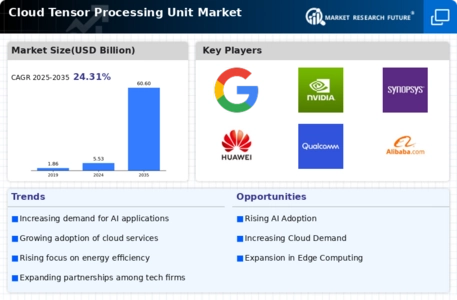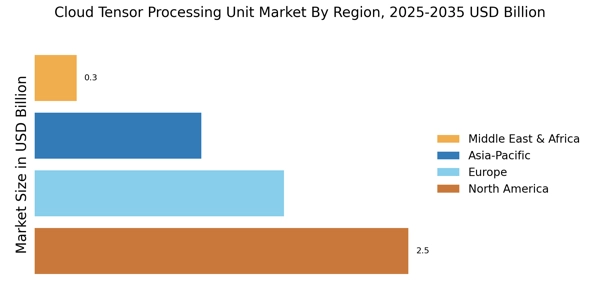Growing Interest in Edge Computing
The Cloud Tensor Processing Unit Market is also influenced by the growing interest in edge computing solutions. As organizations seek to process data closer to the source, the demand for efficient processing units that can operate in edge environments is rising. Cloud tensor processing units are well-suited for this purpose, offering the necessary computational power while minimizing latency. This trend is particularly relevant in sectors such as IoT and autonomous systems, where real-time data processing is crucial. Analysts predict that the edge computing market will expand significantly, potentially reaching a valuation of several billion dollars, thereby positively impacting the Cloud Tensor Processing Unit Market.
Increased Focus on Cost Efficiency
Cost efficiency remains a pivotal driver in the Cloud Tensor Processing Unit Market. Organizations are continually seeking ways to reduce operational costs while maintaining high performance. Cloud tensor processing units offer a cost-effective solution by enabling businesses to leverage powerful computing resources without the need for substantial capital investment in hardware. This shift towards cloud-based solutions is likely to attract more enterprises, particularly small and medium-sized businesses, to adopt tensor processing units. Market trends indicate that the overall cloud services market is expected to grow, with a significant portion attributed to the cost-saving benefits of cloud tensor processing units, thereby enhancing the Cloud Tensor Processing Unit Market.
Advancements in Cloud Infrastructure
The Cloud Tensor Processing Unit Market is benefiting from significant advancements in cloud infrastructure technologies. Innovations in networking, storage, and virtualization are enhancing the capabilities of cloud services, making them more efficient and accessible. These improvements enable organizations to deploy tensor processing units in a cloud environment seamlessly. As cloud infrastructure continues to evolve, it is anticipated that the adoption of cloud tensor processing units will increase, driven by the need for scalable and flexible computing solutions. Market forecasts suggest that the cloud infrastructure sector will grow at a rate of around 15%, further bolstering the Cloud Tensor Processing Unit Market.
Expansion of Data-Driven Decision Making
In the current landscape, the Cloud Tensor Processing Unit Market is witnessing a notable shift towards data-driven decision making. Organizations are increasingly leveraging data analytics to inform strategic choices, optimize operations, and enhance customer experiences. This trend necessitates robust computational resources, which cloud tensor processing units provide. The ability to process large datasets in real-time is becoming essential for businesses across various sectors. As a result, the demand for cloud tensor processing units is expected to rise, with market analysts projecting a growth rate of approximately 12% over the next few years. This expansion underscores the critical role of the Cloud Tensor Processing Unit Market in facilitating effective data utilization.
Rising Demand for High-Performance Computing
The Cloud Tensor Processing Unit Market is experiencing a surge in demand for high-performance computing solutions. Organizations are increasingly relying on advanced computational capabilities to process vast amounts of data efficiently. This trend is driven by the need for faster data analytics, machine learning, and artificial intelligence applications. According to recent estimates, the market for high-performance computing is projected to grow significantly, with a compound annual growth rate of over 10%. As businesses seek to enhance their operational efficiency and gain competitive advantages, the adoption of cloud-based tensor processing units is likely to accelerate, thereby propelling the Cloud Tensor Processing Unit Market forward.


















Leave a Comment